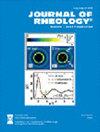Spreading ceramic stereolithography pastes: Insights from shear- and orthogonal-rheology
IF 3.2
2区 工程技术
Q2 MECHANICS
引用次数: 0
Abstract
We study the shear rheological behavior of a commercial stereolithography paste containing ≈50 vol. % of zirconia particles (diameter ≈ 100 nm) with the aim to clarify physical mechanisms occurring during the “scraping” step of this yield stress fluid. Beyond a flow curve characterized by a high zero-shear viscosity accompanied with an overall shear-thinning behavior, we investigate in a systematic way the transient regime through start-up experiments. We demonstrate that a structural transition occurs between 10−2 and 10−1 s−1, resulting in an apparent interruption of the shear-thinning. The corresponding transient response presents a pronounced extra-growth of the shear stress before to stabilize at high strain amplitude and a negative first normal stress difference peak, both effects become stronger at higher shear rates. These observations are rationalized based on the high interparticle friction owing to the polyhedral shape and the roughness of the particles. In addition, relaxation tests following the start-up experiments reveal that the samples submitted to shear rates higher than 10−1 s−1 cannot relax the shear stress to the same level as in low shear rate experiments, suggesting a durable structural modification likely to impact the quality of the parts prior to their debinding and densification. Finally, we utilize orthogonal superposition rheology to illustrate how the application of an oscillatory deformation during the scraping procedure could help to reduce the shear-thinning interruption and improve the stereolithography processing as already observed empirically during scraping.陶瓷立体光刻浆料的铺展:剪切流变学和正交流变学的启示
我们研究了一种商用立体光刻浆料的剪切流变行为,该浆料含有 ≈50 体积百分比的氧化锆颗粒(直径 ≈ 100 纳米),目的是阐明这种屈服应力流体在 "刮削 "步骤中发生的物理机制。除了以高零剪切粘度和整体剪切稀化行为为特征的流动曲线外,我们还通过启动实验系统地研究了瞬态机制。我们证明,在 10-2 和 10-1 s-1 之间发生了结构转变,导致剪切稀化明显中断。相应的瞬态响应在高应变幅稳定之前出现了明显的剪切应力额外增长和负的第一法向应力差峰值,这两种效应在剪切速率较高时变得更强。由于颗粒的多面体形状和粗糙度,颗粒间的摩擦力很大,因此这些观察结果是合理的。此外,启动实验后的松弛测试表明,剪切速率高于 10-1 s-1 的样品无法将剪切应力松弛到与低剪切速率实验中相同的水平,这表明在脱胶和致密化之前,持久的结构改变可能会影响零件的质量。最后,我们利用正交叠加流变学来说明在刮削过程中应用振荡变形如何有助于减少剪切稀化中断,并改善立体光刻加工,这在刮削过程中已经得到了经验观察。
本文章由计算机程序翻译,如有差异,请以英文原文为准。
求助全文
约1分钟内获得全文
求助全文
来源期刊

Journal of Rheology
物理-力学
CiteScore
6.60
自引率
12.10%
发文量
100
审稿时长
1 months
期刊介绍:
The Journal of Rheology, formerly the Transactions of The Society of Rheology, is published six times per year by The Society of Rheology, a member society of the American Institute of Physics, through AIP Publishing. It provides in-depth interdisciplinary coverage of theoretical and experimental issues drawn from industry and academia. The Journal of Rheology is published for professionals and students in chemistry, physics, engineering, material science, and mathematics.
 求助内容:
求助内容: 应助结果提醒方式:
应助结果提醒方式:


